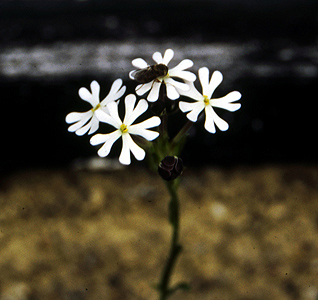Some of the greenhouses’ most delightful but seldom known gems are the Zaluzianskya, Night Phloxes. These are rather misfortunately named so they now appear almost last in any seed or plant list. By then one’s attention may have wandered, or more likely the budget has been exceeded by many times, so good plants may be ignored that would be grabbed if they’d just appeared earlier in the list. Which they did when once named Nycterinia!
Whatever, somehow this small genus of about three dozen species from South Africa has become rather overlooked and they are much less common now than some of them deserve. The most choice by far is Z. capensis, the Night or Cape Phlox, an annual that does indeed bear quite a visual resemblance to garden Phloxes in the form of their flowers. During the day these remain curled in tight purple balls making the plant somewhat insignificant with it’s almost heather like form. But with the cool of the evening these open to pristine white, scented, ‘stars’ and continue through the night closing again the next morning.

It is the evening they come into their own for they possess one of the most delicious floral perfumes, powerful but not overwhelming like Mock Orange or decadent like Gardenia. This sweet perfume is enjoyed by almost everyone who comes across it, a mixture of honey, vanilla, a hint of chocolate and overtones of citrus. Literally mouth-watering (though don’t try to eat the blooms as they’re probably not edible!). This is not the most difficult plant to grow but does require some care and warmth initially. The seed is very fine and needs sowing under glass in March with the most minimal covering of sowing compost, then kept warm and moist and never in cold or wet conditions. Once under way the plants are fairly robust, under cover, somewhat miffy outdoors. They can be treated like most half hardy annuals and planted out in a warm sheltered position after the frosts but really these are better cultivated in pots in the greenhouse.
They are conveniently compact reaching only about a foot or so in height and width and other than occasional dead heading they need very little attention. (Water only to prevent drying out and feed but lightly.) However each evening they will open their blooms and force themselves on your notice as their heavenly sweet scent fills the whole building. Very similar for those who become addicted is Z. villosa, treated much the same as Z. capensis this is a tad more compact and it’s blooms do not close during the day, thus remaining more attractive especially as these have an orange centre. Unscented during the day these also give off a similarly gorgeous scent each evening right through middle and late summer.










